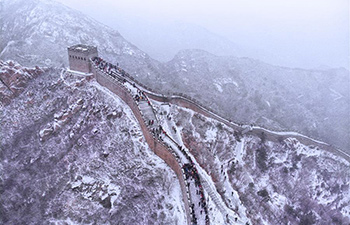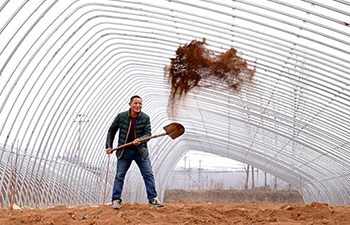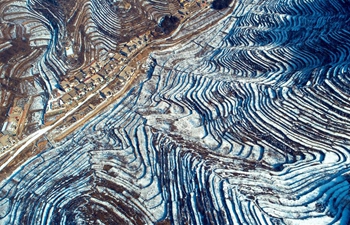HOHHOT, Feb. 15 (Xinhua) -- Before the winter is gone, Liu Peixin has started preparing for the upcoming spring plowing, by frequently visiting the agricultural technology promotion center tens of miles away.
He has consulted issues like market demand this year, water irrigation and fertilizer control.
Liu, 56, is from a village in the city of Bayannur, north China's Inner Mongolia Autonomous Region.
Growing 6.7 hectares of corn, sunflowers and vegetables, Liu brought home 120,000 yuan (17,745 U.S. dollars) in 2018, twice the annual income of previous years.
The rising yield and income were attributed to the guidance of agronomists, who examined local farmland soil and optimized fertilization.
"Farmers like me used to believe that the more fertilizer we used, the more yield we could secure. Obviously, we were wrong," he said. "Farming is a science."
Based on experts' advice, Liu shredded crop straws to nourish the farmland and adopted organic and slow-release fertilizers. Having reduced fertilizer use by 7,000 kg in total, he saved 10,000 yuan in farming cost last year.
"To my surprise, it worked," he said, adding that he harvested more corn and sunflower seeds on the same plot of field.
The farmland of Bayannur is part of Hetao Plain, the floodplain of the Yellow River and near the desert. Annual precipitation is less than 200 mm, one-tenth of the evaporation amount in the area. Farmland kept deteriorating because of salinization, and farmers were forced to lean heavily on fertilization in pursuit of higher yield.
"Overfertilization leads to hardening soil, which will lower the crop production and pollute nearby soil and water," said Li Jie, director of the agricultural technology promotion center in Bayannur's county-level Hanggin Rear Banner.
To curb the situation, Bayannur city government sent agronomists to test the soil, optimize the proportion of nitrogen, phosphorus and potassium in fertilizers and encourage farmers to replace regular chemical fertilizers with organic manure or slow-release fertilizers.
Demonstration fields are set up to prove the effects of agroscience, so as to convince farmers to follow the advice of the agronomists.
"I asked experts to write down the fertilizing details, like a doctor's prescription, which will bring a better income and improve soil quality year after year," said Zhang Yongkai, another farmer who often learned from a demonstration field.
According to the city's agricultural and animal husbandry bureau, optimized fertilizers have been adopted in one-third of the city's total farmland, benefiting more than 300,000 farmers.
Reduced fertilization has also reduced pollution.
Guo Yuhua, the chief engineer of Bayannur city's environmental protection bureau, said Ulan Suhai Lake, the largest freshwater lake along the Yellow River, had seen better water quality in recent years.
Tests show the lake's density of chemical oxygen demand (COD), an important parameter to measure organic pollutants, dropped from 69 mg/L in 2012 to 36 mg/L in 2017.
"Fertilizers used on Hetao Plain farmland are a major source for the lake's pollution, and the significant drop of COD density has shown improved water quality of not only the lake but also the area nearby," Guo said.

















